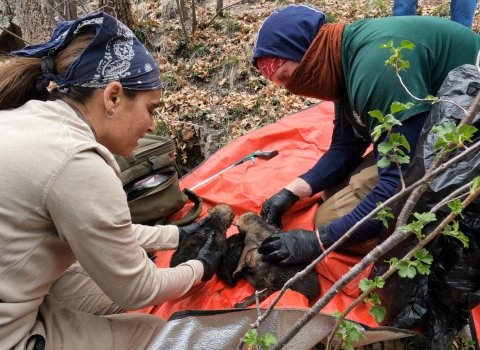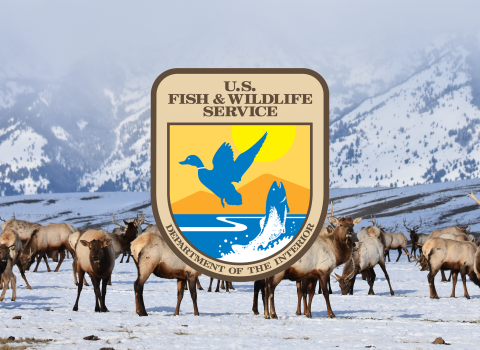A talented young artist from Kansas has taken top honors at the National Junior Duck Stamp Art Contest. A pair of hooded mergansers by 18-year-old Margaret McMullen, will grace the 2021-2022 Junior Duck Stamp, which raises funds to educate and engage our nation’s youth in wildlife and wetlands conservation and outdoor recreation. A panel of five judges chose the entry, painted in acrylic, from among best-of-show entries from 50 states, Washington, D.C. and two U.S. Territories.
“I am so excited that thousands of talented young students from across the United States participated in this year’s Junior Duck Stamp Program, and especially proud to announce the top winners of this prestigious contest,” said Service Principal Deputy Director Martha Williams. “This program is one of our hallmark efforts to engage youth and foster a lifelong connection with the natural world through science, art and language.”
Students in kindergarten through grade twelve participate in their annual state Junior Duck Stamp Program through their school, home, art studio or after-school group, or from a national wildlife refuge national wildlife refuge
A national wildlife refuge is typically a contiguous area of land and water managed by the U.S. Fish and Wildlife Service for the conservation and, where appropriate, restoration of fish, wildlife and plant resources and their habitats for the benefit of present and future generations of Americans.
Learn more about national wildlife refuge , park or nature center. After learning about wetlands, waterfowl and wildlife conservation, they express their learning through a drawing or painting of a duck, goose or swan.
The top piece of art in the nation – chosen at this annual competition – is featured on the Junior Duck Stamp, sales of which support educational programs and activities that nurture our next generation of conservationists.
The Federal Junior Duck Stamp Conservation and Design Program began in 1989 as an extension of the Migratory Bird Hunting and Conservation Stamp, commonly known as the Duck Stamp. The first national Junior Duck Stamp art contest was held in 1993. The stamp encourages students to explore their natural world, participate in outdoor recreation activities, and learn wildlife management principles. Approximately 2,000 Junior Duck Stamps are sold annually for $5 each.
Second place winner was Daniel Schumacher, age 18, from North Dakota, with an acrylic painting of a redhead.
Third place went to 12-year-old Ariah Lowell from Maine who entered a harlequin duck painted in oils.
In addition to the art contest, a Junior Duck Stamp Conservation Message Contest encourages students to express in words the spirit of what they have learned through classroom discussions, research, and planning for their Junior Duck Stamp Contest entries. This year’s winner is Josie Arp, 15, of Arkansas with her message: “When the world turned upside-down nature calmly and quietly laid a blanket of comfort over us all.”
“We are so honored to help run a program where thousands of young people from around the country and all different backgrounds and interests have an opportunity to showcase their talents,” said Assistant Director for Migratory Birds Jerome Ford. “These kids have had to adjust to new learning methods during the past year due to the pandemic. It just shows how important this program is to allow students to turn what they know about wildlife and use their passion to turn that into a piece of personal art they share around the country
This year, nearly 9,000 young artists submitted entries to the Junior Duck Stamp contests around the nation. State coordinators, which include the Service, state wildlife agencies and local nongovernmental employees adjusted to the COVID-19 pandemic in several ways. They offered virtual tours of neighboring wetlands and national wildlife refuges, provided lessons and activities about waterfowl identification and sent art supply packets to students learning from home. The coordinators also mailed letters to students about future conservation careers. Online sketching, painting and journaling videos were made by several local artists to engage students and promote their involvement in the Junior Duck Stamp Program while increasing their observation skills and understanding of waterfowl behavior. For complete contest results, visit https://www.fws.gov/program/junior-duck-stamp.
The Junior Duck Stamp Contest winner receives $1,000. The second place winner receives $500; the third-place winner receives $200; the Conservation Message winner receives $200.
You can buy Junior Duck Stamps online through the U.S. Postal Service and Amplex and at some national wildlife refuges. Proceeds from the sale of Junior Duck Stamps are used for recognition of individuals who submit winning designs in state or national competitions and to further activities related to the conservation education goals of the program.
The first day of sale for the 2021-2022 Federal Duck Stamp and Junior Duck Stamp is planned for June 25, 2021.


